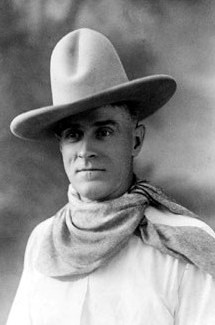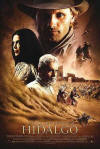Frank Hopkins

|
Frank Hopkins |
|
Soon after the
Walt Disney Studio announced it was going to make a movie about Frank Hopkins
in 2003, representatives of the History Channel contacted the Long Riders’ Guild
seeking advice and assistance. These cynical television editors expressed
concern that they had been unable to verify any of the fantastic achievements
attributed to Hopkins, including his supposed victory of a 3,000 mile endurance
race held in the deserts of Arabia.
Having agreed to investigate Hopkins, the Guild sought the help of more than eighty historians, academics, diplomats, scientists, authors and equestrian experts in five countries. What started as a search for a hero soon turned into an unprecedented international investigation into the activities of the most elusive equestrian charlatan of all time.
| If Frank Hopkins was to be believed, he led one of the most exciting, challenging and colourful (albeit unrecorded) lives in the late nineteenth century. No one rode more miles, eluded more danger, or befriended more famous people than he did. |
Hopkins’ remarkable career supposedly began when he became a dispatch rider for the US government on his twelfth birthday in 1877. Later that same year the perky boy wonder claimed to have rescued Billy the Kid from the Apaches in Arizona. But his amazing career was just beginning.
The counterfeit cowboy claimed to have won more endurance races than anyone in history, including an 1800 mile race from Galveston, Texas, to Rutland, Vermont, in 1886. No such race ever took place.
| Hopkins claimed that it was because of his stunning imaginary victory in this non-existent race that he was hired by Buffalo Bill Cody to be the "star and ringmaster" of the Wild West Show for 32 years. |
Hopkins claimed that it was because of his stunning imaginary victory in this non-existent race that he was hired by Buffalo Bill Cody to be the "star and ringmaster" of the Wild West Show for 32 years. The Curator of the Buffalo Bill Museum at the Buffalo Bill Historical Center confirmed that there was no trace of Hopkins in the Museum’s database of known cast members, acquaintances, employees, or friends of Colonel Cody.
Having invented his endurance racing credentials and faked his friendship with Cody, Hopkins next claimed that the Wild West show paid for him and his mythical mustang Hidalgo to journey to Arabia in 1890. According to the Hopkins mythology, the American was invited to take part in a 3,000 mile race across the burning sands of Arabia. This race had been run, Hopkins said, every year for a thousand years, and until then only the finest Arab horses had been allowed to participate. Hopkins and his mustang stallion, Hidalgo, supposedly won the race with 33 hours to spare. Experts in both Saudi Arabia, and Yemen where the race allegedly started, ridiculed the very idea of such an elaborate equestrian contest.
This Renaissance Man of the Old West also swore he had worked as a buffalo hunter, Indian fighter, African explorer, endurance racer, trick rider, bounty hunter, Rough Rider, big game guide, secret agent and Pinkerton detective. In addition Hopkins falsely claimed to have witnessed the massacre at Wounded Knee.
| Hopkins actually worked as horse handler for a circus, a subway tunnel digger and an underwater diver. |
While Hopkins lied about many things, he did in fact plagiarize large sections of the 1932 first edition of Black Elk Speaks and slandered many American legends including Sitting Bull, President Teddy Roosevelt, Buffalo Bill Cody, author Zane Grey and western film star William S. Hart.
He also forged his equestrian travel career by claiming to have made a winter-time equestrian journey from Germany to Mongolia “in a few weeks.” And he stole the genuine awards and achievements of legitimate Long Rider heroes. The fake Long Rider claimed that he had ridden alongside President Teddy Roosevelt and the Rough Riders in a famous parade through New York. He stole that achievement from Bud and Temple Abernathy, who at the age of ten and six rode from New York to San Francisco – alone – in sixty-two days.
|
Nor had Hopkins been awarded a medal for bravery. He stole that accomplishment from Two Gun Nan Aspinwall, the first woman to ride across the United States alone. |
In fact no evidence could be found to substantiate any of these or dozens of other equally implausible claims. Hopkins had never ridden alongside Buffalo Bill. He had instead deserted his wife and children during the Great Depression so as to engage in a bigamous marriage with a younger neighbour. He had never won any endurance races. After he left his family penniless he earned his living delivering ice and digging tunnels. He didn’t own a ranch at Fort Laramie. He boarded with his girlfriend’s mother on Long Island.
| In this 1920s newspaper account Hopkins mentions his Canadian wife and their many children, whom he later abandoned. The account also provides one of the counterfeit cowboy’s many tall tales, but goes on to state that having laid aside his six-gun the former gunslinger had taken up employment digging a subway tunnel. |
Hopkins had been able to peddle a series of elaborate fantasises beginning in the 1920s because a naďve press had failed to ask for any proof. The list of Hopkins’ victims included many major newspapers, several magazines, famous authors such as J. Frank Dobie, and the Walt Disney Studio. One such victim was noted free-lance writer Anthony Amaral. Even though he had been warned by the Library of Congress and the Editor of Western Horseman magazine that there was no evidence to support Hopkins’ claims, Amaral published a false story which later served as the inspiration for the Disney film, Hidalgo.
Once the Guild and its academic allies uncovered and documented the extent of the Hopkins Hoax, it offered to provide all of the evidence to Disney CEO Michael Eisner. That offer was never acknowledged. Instead the studio went on the offensive.
John Fusco, the screenwriter of Hidalgo, told the Hollywood Reporter on March 13th 2003, "I've been researching Hopkins life for more than 12 years now and compiled research from more than 15 well-respected historians that verify this story."
Fusco's claim was repeatedly ridiculed by academics, authors and various types of experts. Here are a few examples.
"There is absolutely no record of any horse race in the past staged from Aden!" Ghalib Al-Quaiti, the last ruling Sultan of Yemen.
"Did this man Hopkins say anything true?" Dr. John Gable, Executive Director, Theodore Roosevelt Association.
"Hopkins' claims are so outrageously false that one wonders why the Disney people were attracted to this material at all - except of course the constant propensity to make money under any conditions available. One need only peruse the mass of material purporting to deal with the Ogallala Sioux and Hopkins' claims regarding them to see that almost anything can be acceptable to the money-mad titans of Hollywood. .Hopkins should have been awarded the World's Greatest Liar award." Dr. Vine DeLoria, Jr., leading Native American scholar, retired professor emeritus of history at the University of Colorado and author of many acclaimed books.
"Yes, the Hopkins story is exciting. It has all of the ingredients that make a good story and in turn a good motion picture. But to misrepresent to the motion picture viewing public that the upcoming film is a "true story" is not only misleading but it raises a serious question about the credibility of the Disney organization....Hopkins so-called 'true story' may be the first major hoax of the 21st century perpetuated on the US public and motion picture public. For the scriptwriter and Disney to call it "true" is not only inaccurate but misleading. The Disney Studio has been built on public trust. To claim that something is true when it is not breaks that trust. So long as they ignore the truth, it is irresponsible. The company is not performing in a responsible manner." Professor David Dary, emeritus professor and former head of the Gaylord College of Journalism at the University of Oklahoma.
As these quotes demonstrate, highly respected people were honestly concerned that the Disney studio was involved in deliberately peddling a historical falsehood to a gullible public.
Nevertheless, despite a mountain of evidence demonstrating that Hopkins had invented the "Oceans of Fire" race depicted in the Disney movie, as well as his mythical mustang, Hidalgo, Fusco and his masters at the Disney studio defiantly continued to claim that the Hidalgo movie was authentic. The most notorious example of the studio's dismissal of the truth came about when a Disney employee spoke in an unguarded manner to Peter Harrigan, an English reporter stationed in Arabia.
Nina Heyn was Disney's Executive Director of International Publicity at the time of the movie’s release. She sent the public a chilling message when she told Harrigan, "No one here really cares about the historical aspects. Once a picture has been shot, people move on to others. We're like a factory. It’s like making dolls. Once the latest doll is out we go onto the next one. If it transpires that the historical aspects are in question I don't think people would care that much. Hidalgo is a family film. It has little to do with reality."
Dr. Donald Worcester was an Ida and Cecil Green Distinguished Emeritus at Texas Christian University, the author of many books, including "The Spanish Mustang," and a victim of the Hopkins Hoax. When Dr. Worcester realized that he had been duped by Hopkins’ mythical account about a non-existent horse race across Arabia, he issued this stern warning.
"If the Walt Disney studio does not admit that the movie ‘Hidalgo’ is fiction, then years from now people will be misled into believing that it is a true story."
The Disney Corporation ignored Dr. Worcester and everyone else who initially urged them to admit that Hidalgo was in fact a fantasy. In the intervening years, despite a growing mountain of evidence proving that Hopkins deceived the public, the Walt Disney studio continues to wrongfully claim that the movie Hidalgo is "based on a true story." As a consequence the Hidalgo film has come to be viewed as an act of deliberate cinematic deception.
 |
Walt Disney Studios – Home of “Darby O’Gill and the Little People,” a tale about a wily Irishman and his battle of wits with leprechauns, and Hidalgo, a tale about pony baloney. |
Likewise Frank Hopkins has been revealed as the greatest equestrian travel rogue of all time and the man responsible for having perpetrated the most elaborate and destructive equestrian myth in modern history.
To view the extensive Hopkins Hoax file, which includes documentation exposing Hopkins’ false claims, extensive coverage in the press and a vast collection of images, maps and documents, please click here.